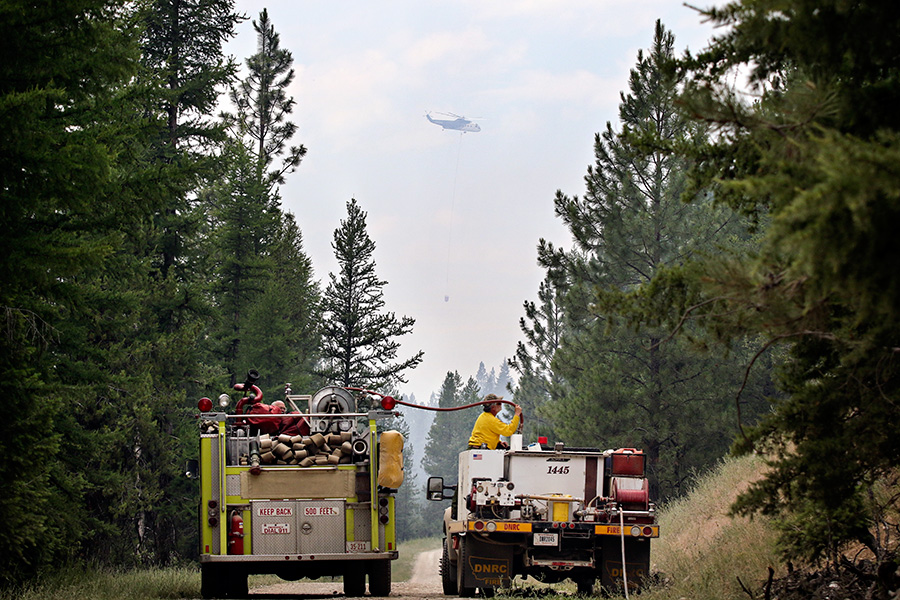‘Above Average’ Fire Season Predicted as Officials Prepare for COVID-19 Mitigation
A hot, dry summer is expected while agencies work to prevent and manage coronavirus exposure in fire camps
By Maggie Dresser
As parts of Montana continue a warm and dry trend this spring, officials are predicting an “above-average” fire season this summer along with navigating complicated firefighting operations due to COVID-19.
“This year will be unlike any year before it,” Gov. Steve Bullock said at an interagency fire briefing conducted via Zoom on June 16. “But seeing the heightened collaboration gives me confidence.”
Northern Rockies Predictive Services Meteorologist Michael Richmond forecasts an above-average fire season in July, August and September based on dry fuels and warm temperatures in much of the state, despite an above-average snowpack.
“This would certainly lend itself to a more active year than last year even if we don’t have as much lightning to ignite a lot of large fires,” Richmond said.
But even if Montana’s fire season isn’t active, Richmond says the smoke from fires in Idaho, Oregon, Washington and Northern California will likely blow into the western part of the state, where it will settle into valleys.
“I think with high confidence we can expect a much better chance of smoke coming into western and central portions of the state … further west with valley inversions trapping everything,” Richmond said.
The pandemic is complicating the fire season, with state and federal agencies working to prevent the spread of coronavirus in working conditions that typically call for close contact between firefighters, who already work in unsanitary conditions.
“We have to definitely take into account COVID-19,” said Leanne Marten, Northern Regional Forester for the U.S. Forest Service. “We have to make sure we don’t get so funneled with COVID that all the other risks are taking a back seat inadvertently.”
Agencies are working to mitigate COVID-19 exposure by separating firefighters into “Module as One,” groups, which encourages groups limited to 10. Units will work, eat and sleep together while limiting interactions with other crews.
Northern Rockies Coordinating Group has also compiled firefighting prevention protocols, which include smaller morning briefings, minimizing group training and conducting frequent temperature checks and sanitation.
“Module as One (is) a concept we believe will help minimize COVID-19 not just for firefighters,” said John Mehlhoff, the Montana and The Dakotas State Director of the Bureau of Land Management (BLM). “The module is a family unit. We put a crew in there and that unit tries to keep themselves socially distant from other crews and people they come into contact with.”
While large fires usually have a well-attended morning briefing, Montana Department of Natural Resources and Conservation (DNRC) Director John Tubbs says only certain individuals will be selected to hear the briefing, who will then report back to their group. Briefings will also be held outside.
Additional fire resources also might look different this year with Canada’s border closed until at least July 21. International firefighters often cross borders to assist in fire suppression, but DeGrosky says cross-border movement will be tricky this season. While he’s confident border movement will be possible, he says it will probably be interrupted. Canada is also predicted to have an active fire season, DeGrosky said.
Since Montana’s fire season starts later than the rest of the country, typically in July and August, officials say they will learn from earlier fire operations, like those currently active in Arizona.
Crews also got some practice this month at the Lump Gulch Fire, a 1,500-acre fire outside of Helena, which ignited on June 13 and was 50% contained as of June 18, according to InciWeb. Around 150 personnel responded to the fire, Tubbs said.
Currently in Arizona, many personnel are working virtually and firefighters are receiving boxed meals instead of the historically catered food tents at fire camps.
“One of the drawbacks of a module is if one person becomes ill or is exposed … and doesn’t realize it, a whole crew and a whole module could go down,” Marten said.
If crewmembers are exposed to COVID-19, officials say they will conduct an “identify, isolate and trace” method inside the fire camp to prevent further exposure.
While COVID-19 is new to the world, officials say disease outbreaks are nothing new in fire camps, and DNRC Fire and Aviation Bureau Chief Mike DeGrosky says there was a whooping cough outbreak in 2017.
“We isolated them and we kept the people that were sick quarantined engaged in county health,” DeGrosky said. “I think that is a lesson learned that we can emulate. I just want to remind people there have been outbreaks of infectious diseases in fire camps for a long time and our incident commanders are hyperaware of COVID-19.
While COVID-19 throws a hurdle in firefighting this season, officials are confident that agencies are prepared and will not let the pandemic prevent operations.
“You plan for worst-case scenario and then you work backward from there,” Marten said. “It’s really being prepared. We’ll have resources, we’ll adapt and we’ll evolve.”